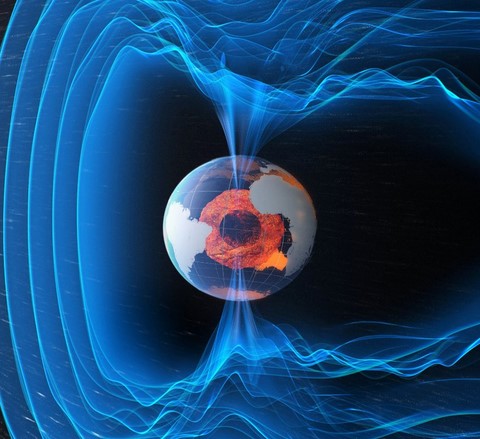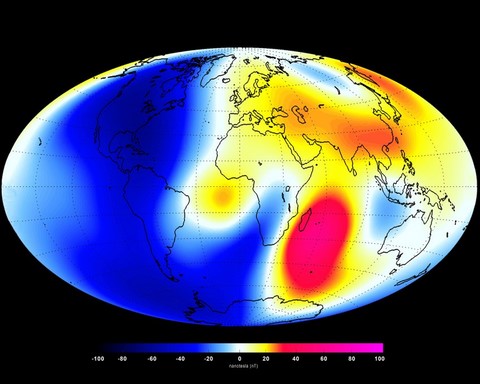Earth's weakening magnetic field
Three satellites of the European Space Agency (Esa) have measured the magnetic field of Earth more precisely than ever before. For a good purpose – our defence-shield against harmful particle storms from space has been weakening of late.
This mission was long overdue. Scientists know from stone samples from the bottom of the Atlantic Ocean that the magnetic field of Earth changes its direction on average every 780.000 years. And the last polar reversal, the Brunhes-Matuyama-Reversal, happened some 780.000 years ago. The next reversal could come soon, at least on the geological time-scale. (See insert)
The magnetic field serves Earth as a protective shield against high energy particle storms. These are regularly hurled into space by the sun – and they could become a danger for our atmosphere: the high speed particles might tear away and carry forth bit by bit the molecules of the gas envelope. This may have well happened on Mars, for example, which does not possess a magnetic field – and has only a very thin atmosphere.
It is our good luck that the high-energy particles are diverted around the Earth along the magnetic field lines, in such a way that a protective cocoon is created for our planet. Even in the case of a polar reversal, there might be no danger for life on Earth.
Picture: ESA/ATG Medialab Artist's rendition


Still, the magnetic field of Earth has been undergoing changes with a speed that renders scientists perplex. In the past one hundred years, it has diminished globally by a good five percent. In some areas, such as the Atlantic before the coast of Brazil, it has lost even more of its strength. In the area of this so-called South-Atlantic anomaly, a minus of five percent has been observed within a mere ten or fifteen years.
A dynamic system: this picture displays the changes in intensity of the magnetic field between January and June 2014. It has weakened especially over the Americas and parts of the South Atlantic, but gained in strength over the Indian Ocean.
Image: ESA/DTU Space
Three European satellites have now measured more precisely than never before the speed at which this change is proceeding. The "Swarm" satellites are flying around Earth since Fall of 2013. The European Space Agency (Esa) has made public the first results of the “Swarm” mission in June 2014 at a congress in Copenhagen.
"We were able to observe a general weakening,” reported Nils Olsen of the Danish Technical University (DTU), "but in many areas, there was also an increase." So that the magnetic field has been losing strength during the six months of the mission mostly above North and South America, but has become stronger over the Indian Ocean.
The three identically constructed satellites "Alpha", "Bravo" and "Charlie" are equipped with magnetometers, which are able to evaluate the direction and intensity of the magnetic field. The instruments are installed on elongated arms, four meters in length, in such a way that they suffer as little interference as possible from the other technical equipment on board the satellites.
The Brunhes-Matuyama Reversal happened much faster than had been thought hitherto, as a team of scientists investigating a fossil lake in Italy recently found out. The change occurred in just about one hundred years, they write in the scientific magazine Geophysical Journal International (Extremely rapid directional change during B-M polarity reversal).
"It’s astonishing, how fast the reversal occurred,” says Courtney Sprain of University of California at Berkeley. Almost as fast as during the short lived magnetic reversal 41.000 year ago, also known as the “geomagnetic excursion.” The magnetic North pole wandered within 200 years to the South pole, remained there for 440 years, then it moved back. These short excursions are even more frequent than the recurring long wanderings.
Sprain und her colleagues have analysed sediments of a fossil lake in the plain of Sulmona in the Appenine, East of Rome. The prevailing magnetic directions can be reconstrued from the geological layers. Argon-argon dating was used, in which the relation between two different argon isotopes are compared in order to date layers of sediment.
Holger Dambeck
From Der Spiegel, Oct. 19, 2014
As the satellites are on flight paths close to each other, their measurements can be especially precise: "Alpha" and "Charlie" are flying together at an altitude of 460 kilometers, "Bravo’s" path is at 510 kilometers. The position of the satellites had to be revised after take-off because one of the back-up magnetometers had failed.
"We do not yet have a final result", says Olsen. After all, the mission only just started. The "Swarm"-satellites are expected to fly for at least four more years. Esa is hoping that, by putting them on fuel-saving orbits, they might be able to get even more out of them. They talk about ten years.
And there is plenty for the satellites to observe: they are able to record how solar storm are temporarily creating bumps in the magnetic field, how salt-ions dissolved in ocean currents constantly affect the magnetic-field’s intensity – and how various kinds of rocks in the Earth crust affect it.
But even more fascinating is the insight into Earth’s deep interior: the processes there are responsible for over 95 percent of the strength of the magnetic field: around a solid core of iron and nickel, there is a zone in which the metal is in a liquid state. The solid interior core of the Earth and its liquid surroundings rotate with different speeds, while convection currents are forming in the liquid zone which move by about ten kilometres a year.
During this process, large amounts of liquid metal rise in areas which are farther distant from the centre. The rotation of Earth and the mass inertia of the metal interact to create spiral, corkscrew paths. Because a weak magnetic field is already present, this induces an electric current – which in turn increases the strength of the magnetic field. It’s all called geodynamo in scientific jargon.
But this magnetic engine is subjected to a steady wandering. Which is why its pole also wanders around on the Earth’s surface. The magnetic South pole in the Canadian Arctic is shifting its position by 90 meters a day. Presently, according to the new data, it will move up even higher North – according to the scientists of "Swarm," until 2019. Then the magnetic pole will probably make itself on its way in the direction of Siberia.
Christoph Seidler
Der Spiegel, June 19, 2014
Translated by Anne-Marie de Grazia

